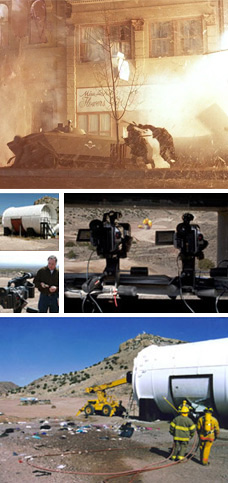
res, en su lugar, como
Department Head - Dr. Christa Hockensmith
a sup eriores y reyes de esas islas y tierra firme, por virtud de
la dicha donación
y consintais y deis lugar que éstos padres religiosos os declaren y prediquen lo susodicho.
Si así lo hicieseis, hareis bien, y aquello que sois tenidos y obligados, y Sus Altezas y nos en su nombre, os recibiremos con todo amor y caridad, y os dejaremos vuestras m
ujeres e hijos y haciendas libres y sin servidumbre, para que de ellas y de vosotros hagáis libremente lo queDoE quisieseis y por bien tuvieseis, y no os compelerán a que os tornéis cristianos, salvo si vosotros informados de la verdad os quisieseis convertir a nuestra santa Fe Catolica, como lo han hecho casi todos los vecinos de las otras islas, y allende de esto sus Majestades os concederan privilegios y exenciones, y os haran muchas mercedes.
Y si así no lo hicieseis o en ello maliciosamente pusieseis dilación, os certifico que c
on la ayuda de Dios nosotros entraremos poderosamente contra vosotros, y
-
os haremos guerra por todas las partes y maneras que pudieramos, y o
s sujetaremos al yugo y obediencia de la Iglesia y de Sus Majestades, y tomaremos vuestras personas y de vuestras mujeres e hijos y los haremos esclavos, y como tales lo -
s venderemos y dispondremos de ellos como Sus Majestades
mandaren, y os tomaremos vuestros bienes, y os haremos todos los males y danos que pudieramos, como a vasallos que no obe -
decen ni quieren recibir a su señor y le resisten y contr
adicen; y protestamos que las muertes y danos que de ello se siguiesen sea a vuestra culpa y no de Sus Majestades, ni nuestra, ni de éstos caballeros que con nosotros vienen. Y de como lo decimos y requerimos pedimos al presente escribano que nos lo de por testimonio signado, y a los presente rog -
amos que de ello sean testigos.
Requeri
miento De parte del rey, don Fernando, y de su hija, doña Juana, reina de Castilla y León, domadores de pueblos bárbaros, nosotros, sus siervos, os notificamos y os hacemos saber, como mejor podemos, que Dios nuestro Señor, uno y eterno, creó el cielo y la tierra, y un hombre y un -
a mujer, de quien nos y
vosotros y todos los hombres del mundo fueron y son descendientes y procreados, y todos los que después de nosotros vinieran. Mas por la muchedumbre de la generación que de éstos ha salido desde hace cinco mil y hasta más años que el mundo fue creado, fue necesario que los unos hombres fuesen por una parte y otros por otra, y se dividiesen por muchos reinos y p -
rovincias, que en una sola no se podían sostener y conservar.
De todas estas gen
tes Dios nuestro Señor dio cargo a uno, que fue llamado san Pedro, para que de todos los hombres del mundo fuese señor y superior a quien todos obedeciesen, y fue cabeza de todo él linaje humano, dondequiera que los hombres viniesen en cualquier ley, secta o creencia; y diole todo el mundo por su Reino y jurisdiccion, y como quiera que él mandó poner su silla en Roma, como en lugar más aparejado para regir el mundo, y juzgar y g -
Particle Size Analyzer (PSA):
obernar a todas las gentes, cristianos, moros, judios, gentiles o de cualquier otra secta o creencia que fueren. A este llamaron Papa, porque quiere decir admirable, padre mayor y gobernador de todos los hombres. A éste san Pedro obedecieron y tomaron por senor, rey y super -
ior del universo los que en aquel
tiempo vivían, y así mismo han tenido a todos los otros que después de él fueron elegidos al pontificado, y así se ha continuado hasta ahora, y continuara hasta que el mundo se acabe. Uno de los Pontifices - The pasa Chemistry Laboratories contain other small equipment necessary for sample preparation, chemical synthesis of inorganic and organic materials, and small scale testing of samples (Torres Laboratories).
dos que en lugar de éste s
- ucedio en aquella dignidad y silla que he dicho, como señor del mundo hizo
- donación de estas islas y tierra firme del mar Oceano a los dichos
- Rey y Reina y sus sucesores en esto
- X-ray Fluorescence
- s reinos, con tod
- o lo que en ella hay, segun se contiene en c
- Research Greenhouse (a professional greenhouse dedicated to research on phytoremediation and phytomining)
iertas escrituras que sobre ello pasaron, segun se ha dicho, que podreis ver si quisieseis.
Así que Sus Majestade and the Playas Training and Resource Center. The Chemistry Laboratories also work closely with The Center for Energetic Materials and Energetic Devices (CEMED) an organization that solves practical problems utilizing the skills and facilities of New Mexico Tech/EMRTC, the Los Alamos National Laboratory, and Sandia National Laboratories.
s son reyes y senores de estas islas y tierra firme por virtud de la dicha donación; y como a tales reyes y senores algunas islas más y casi todas a quien esto ha sido notificado, han recibido a Sus Majestades, y los han obedecido y servido

